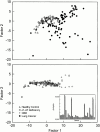Detection of lung cancer by sensor array analyses of exhaled breath
- PMID: 15750044
- PMCID: PMC2718462
- DOI: 10.1164/rccm.200409-1184OC
Detection of lung cancer by sensor array analyses of exhaled breath
Abstract
Rationale: Electronic noses are successfully used in commercial applications, including detection and analysis of volatile organic compounds in the food industry.
Objectives: We hypothesized that the electronic nose could identify and discriminate between lung diseases, especially bronchogenic carcinoma.
Methods: In a discovery and training phase, exhaled breath of 14 individuals with bronchogenic carcinoma and 45 healthy control subjects or control subjects without cancer was analyzed. Principal components and canonic discriminant analysis of the sensor data was used to determine whether exhaled gases could discriminate between cancer and noncancer. Discrimination between classes was performed using Mahalanobis distance. Support vector machine analysis was used to create and apply a cancer prediction model prospectively in a separate group of 76 individuals, 14 with and 62 without cancer.
Main results: Principal components and canonic discriminant analysis demonstrated discrimination between samples from patients with lung cancer and those from other groups. In the validation study, the electronic nose had 71.4% sensitivity and 91.9% specificity for detecting lung cancer; positive and negative predictive values were 66.6 and 93.4%, respectively. In this population with a lung cancer prevalence of 18%, positive and negative predictive values were 66.6 and 94.5%, respectively.
Conclusion: The exhaled breath of patients with lung cancer has distinct characteristics that can be identified with an electronic nose. The results provide feasibility to the concept of using the electronic nose for managing and detecting lung cancer.
Figures


Comment in
-
Can the electronic nose really sniff out lung cancer?Am J Respir Crit Care Med. 2005 Oct 15;172(8):1060; author reply 1060-1. doi: 10.1164/ajrccm.172.8.958. Am J Respir Crit Care Med. 2005. PMID: 16216842 No abstract available.
References
-
- Munoz BC, Steinthal G, Sunshine S. Conductive polymer-carbon black composites-based sensor arrays for use in an electronic nose. Sensor Rev 1999;19:300–305.
-
- Kermany BG, Schiffman SS, Nagle HT. A novel method for reducing the dimensionality in a sensor array. IEEE Trans Instr Meas 1998;47:728–741.
-
- Kermany BG, Schiffman SS, Nagle HT. Using neural networks and genetic algorithms to enhance performance in an electronic nose. IEEE Trans Biomed Eng 1999;46:429–439. - PubMed
-
- Gardner JW, Bartlett PN. Electronic noses: principles and applications. Oxford, UK/New York: Oxford University Press; 1999.
Publication types
MeSH terms
Grants and funding
LinkOut - more resources
Full Text Sources
Other Literature Sources
Medical

